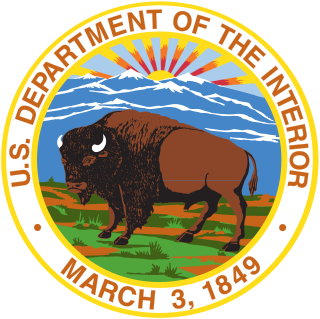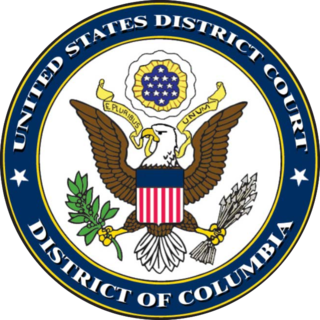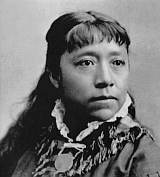
The United States Department of the Interior (DOI) is the United States federal executive department of the U.S. government responsible for the management and conservation of most federal lands and natural resources, and the administration of programs relating to Native Americans, Alaska Natives, Native Hawaiians, territorial affairs, and insular areas of the United States. About 75% of federal public land is managed by the department, with most of the remainder managed by the United States Department of Agriculture's United States Forest Service.
The Federal Old-Age and Survivors Insurance Trust Fund and Federal Disability Insurance Trust Fund are trust funds that provide for payment of Social Security benefits administered by the United States Social Security Administration.

Larry J. Echo Hawk is an attorney, legal scholar and politician. In 2012, he was named as a general authority of The Church of Jesus Christ of Latter-day Saints. On May 20, 2009, Echo Hawk joined the administration of U.S. President Barack Obama as the United States Assistant Secretary of the Interior for Indian Affairs. He previously served as the elected Attorney General of Idaho from 1991 to 1995, being the first Native American elected to that position. He also served two terms in the State House of Idaho.

The Bureau of Indian Affairs (BIA) is an agency of the federal government of the United States within the U.S. Department of the Interior. It is responsible for the administration and management of 55,700,000 acres (225,000 km2) of land held in trust by the United States for Native Americans in the United States, Native American Tribes and Alaska Natives.
The Western Shoshone comprise several Shoshone tribes that are indigenous to the Great Basin and have lands identified in the Treaty of Ruby Valley 1863. They resided in Idaho, Nevada, California, and Utah. The tribes are very closely related culturally to the Paiute, Goshute, Bannock, Ute, and Timbisha tribes.
The California Valley Miwok Tribe is a federally recognized tribe of Miwok people in San Joaquin County and Calaveras County, California. They were previously known as the Sheep Ranch Rancheria or the Sheep Ranch Rancheria of Me-Wuk Indian of California. The California Valley Miwok are Sierra Miwok, an indigenous people of California.

Cobell v. Salazar is a class-action lawsuit brought by Elouise Cobell (Blackfeet) and other Native American representatives in 1996 against two departments of the United States government: the Department of Interior and the Department of the Treasury for mismanagement of Indian trust funds. It was settled in 2009. The plaintiffs claim that the U.S. government has incorrectly accounted for the income from Indian trust assets, which are legally owned by the Department of the Interior, but held in trust for individual Native Americans. The case was filed in the United States District Court for the District of Columbia. The original complaint asserted no claims for mismanagement of the trust assets, since such claims could only properly be asserted in the United States Court of Federal Claims.
The National Historic Preservation Act of 1966 (NHPA) envisioned a funding source to provide states with matching funds to implement the Act. The Act was to be implemented through partnerships with states, Indian Tribes, Native Hawaiians, local governments, nonprofit organizations, and the private sector. It brought forth state programs to implement much of the Act; a National Register of Historic Places encompassing a wide range of sites and structures deemed historic; partnerships at all levels of government; incentives; assistance; and reviews. The NHPA endorsed the use of federal financial support for the national preservation program and called for two basic categories of assistance, both of which provide funding, rather than technical assistance, for historic preservation projects and to individuals for the preservation of properties listed in the National Register of Historic Places. Since enactment in 1966, repeated efforts to fund the HPF was realized after a 10-year campaign when consistent funding was authorized on September 28, 1976, through Public Law 94-422. The law amended the National Historic Preservation Act to establish a funding source known as the Historic Preservation Fund for a historic preservation grant program to provide assistance to non-federal entities.
The Treaty of Ruby Valley was a treaty signed with the Western Shoshone in 1863, giving certain rights to the United States in the Nevada Territory. The Western Shoshone did not cede land under this treaty but agreed to allow the US the "right to traverse the area, maintain existing telegraph and stage lines, construct one railroad and engage in specified economic activities. The agreement allows the U.S. president to designate reservations, but does not tie this to land cessions."
Seminole Nation v. United States, 316 U.S. 286 (1942), was a United States Supreme Court case.

The Tuvalu Trust Fund is an international sovereign wealth fund established to benefit Tuvalu, a small, central Pacific island nation, by providing income to cover shortfalls in the national budget, underpin economic development, and help the nation achieve greater financial autonomy. The Tuvalu Trust Fund was established in 1987 by the United Kingdom, Australia and New Zealand.

The Indian Self-Determination and Education Assistance Act of 1975 authorized the Secretary of the Interior, the Secretary of Health, Education, and Welfare, and some other government agencies to enter into contracts with, and make grants directly to, federally recognized Indian tribes. The tribes would have authority for how they administered the funds, which gave them greater control over their welfare. The ISDEAA is codified at Title 25, United States Code, beginning at section 5301.
The Winnemucca Indian Colony of Nevada is a federally recognized tribe of Western Shoshone and Northern Paiute Indians in northwestern Nevada.
The bill to amend the Act of March 1, 1933, to transfer certain authority and resources to the Utah Dineh Corporation., and for other purposes. This bill was introduced on the sentate floor by Rep. Robert Bennett (R-UT) on 21 September 2009. It was refereed to the Committee on Indian Affairs. On December 9, 2009 Senate Committee on Indian Affairs held hearing 111-538. No further action was taken by the Committee.
The Utah Dineh Corporation is a nonprofit organization which was established in order to maintain the Utah Navajo Oil Reserve revenues in the Aneth Oil Field section of Utah. Much of this area is within the Utah Navajo side of San Juan County, Utah.

The Cherokee Commission, was a three-person bi-partisan body created by President Benjamin Harrison to operate under the direction of the Secretary of the Interior, as empowered by Section 14 of the Indian Appropriations Act of March 2, 1889. Section 15 of the same Act empowered the President to open land for settlement. The Commission's purpose was to legally acquire land occupied by the Cherokee Nation and other tribes in the Oklahoma Territory for non-indigenous homestead acreage.
Salazar v. Ramah Navajo Chapter, 567 U.S. 182 (2012), was a United States Supreme Court case in which the Court held that the United States government, when it enters into a contract with a Native American (Indian) tribe for services, must pay contracts in full, even if congress has not appropriated enough money to pay all tribal contractors. The case was litigated over a period of 22 years, beginning in 1990, until it was decided in 2012.

The Fort McDermitt Paiute and Shoshone Tribe is a federally recognized tribe of Northern Paiute and Western Shoshone peoples, whose reservation Fort McDermitt Paiute and Shoshone Tribes of the Fort McDermitt Indian Reservation spans the Nevada and Oregon border next to Idaho. The reservation has 16,354 acres in Nevada and 19,000 acres in Oregon.

The Military Construction and Veterans Affairs, and Related Agencies Appropriations Act, 2014 is an appropriations bill that was introduced into the United States House of Representatives during the 113th United States Congress. The bill would appropriate money to various government agencies related to the United States Department of Defense and the United States Department of Veterans Affairs. This funding would be used during fiscal year 2014, which ends September 30, 2014. According to its committee report, "the purpose of the bill is to support our military and their families and provide the benefits and medical care that our veterans have earned for their service." The report also indicated that the Committee had made its decisions with the national debt and budget deficit in mind.








